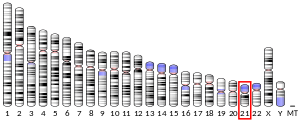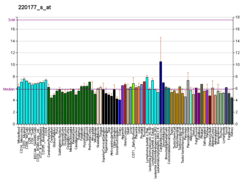TMPRSS3
Transmembrane protease, serine 3 is an enzyme that in humans is encoded by the TMPRSS3 gene.[5][6][7]
Function
This gene encodes a member of the serine protease family. The encoded protein contains a serine protease domain, a transmembrane domain, an LDL receptor-like domain, and a scavenger receptor cysteine-rich domain. Serine proteases are known to be involved in a variety of biological processes, whose malfunction often leads to human diseases and disorders. This gene was identified by its association with both congenital and childhood onset autosomal recessive deafness. This gene is expressed in fetal cochlea and many other tissues, and is thought to be involved in the development and maintenance of the inner ear or the contents of the perilymph and endolymph. This gene was also identified as a tumor associated gene that is overexpressed in ovarian tumors. Four alternatively spliced variants have been described, two of which encode identical products.[7]
References
- 1 2 3 GRCh38: Ensembl release 89: ENSG00000160183 - Ensembl, May 2017
- 1 2 3 GRCm38: Ensembl release 89: ENSMUSG00000024034 - Ensembl, May 2017
- ↑ "Human PubMed Reference:".
- ↑ "Mouse PubMed Reference:".
- ↑ Masmoudi S, Antonarakis SE, Schwede T, Ghorbel AM, Gratri M, Pappasavas MP, Drira M, Elgaied-Boulila A, Wattenhofer M, Rossier C, Scott HS, Ayadi H, Guipponi M (Jul 2001). "Novel missense mutations of TMPRSS3 in two consanguineous Tunisian families with non-syndromic autosomal recessive deafness". Hum Mutat. 18 (2): 101–8. doi:10.1002/humu.1159. PMID 11462234.
- ↑ Wattenhofer M, Di Iorio MV, Rabionet R, Dougherty L, Pampanos A, Schwede T, Montserrat-Sentis B, Arbones ML, Iliades T, Pasquadibisceglie A, D'Amelio M, Alwan S, Rossier C, Dahl HH, Petersen MB, Estivill X, Gasparini P, Scott HS, Antonarakis SE (Mar 2002). "Mutations in the TMPRSS3 gene are a rare cause of childhood nonsyndromic deafness in Caucasian patients". J Mol Med. 80 (2): 124–31. doi:10.1007/s00109-001-0310-6. PMID 11907649.
- 1 2 "Entrez Gene: TMPRSS3 transmembrane protease, serine 3".
Further reading
- Guipponi M, Antonarakis SE, Scott HS (2007). "TMPRSS3, a type II transmembrane serine protease mutated in non-syndromic autosomal recessive deafness". Front. Biosci. 13 (13): 1557–67. doi:10.2741/2780. PMID 17981648.
- Bonné-Tamir B, DeStefano AL, Briggs CE, et al. (1996). "Linkage of congenital recessive deafness (gene DFNB10) to chromosome 21q22.3". Am. J. Hum. Genet. 58 (6): 1254–9. PMC 1915077. PMID 8651303.
- Wallrapp C, Hähnel S, Müller-Pillasch F, et al. (2000). "A novel transmembrane serine protease (TMPRSS3) overexpressed in pancreatic cancer". Cancer Res. 60 (10): 2602–6. PMID 10825129.
- Hattori M, Fujiyama A, Taylor TD, et al. (2000). "The DNA sequence of human chromosome 21". Nature. 405 (6784): 311–9. doi:10.1038/35012518. PMID 10830953.
- Underwood LJ, Shigemasa K, Tanimoto H, et al. (2001). "Ovarian tumor cells express a novel multi-domain cell surface serine protease". Biochim. Biophys. Acta. 1502 (3): 337–50. doi:10.1016/s0925-4439(00)00058-2. PMID 11068177.
- Scott HS, Kudoh J, Wattenhofer M, et al. (2001). "Insertion of beta-satellite repeats identifies a transmembrane protease causing both congenital and childhood onset autosomal recessive deafness". Nat. Genet. 27 (1): 59–63. doi:10.1038/83768. PMID 11137999.
- Ben-Yosef T, Wattenhofer M, Riazuddin S, et al. (2001). "Novel mutations of TMPRSS3 in four DFNB8/B10 families segregating congenital autosomal recessive deafness". J. Med. Genet. 38 (6): 396–400. doi:10.1136/jmg.38.6.396. PMC 1734898. PMID 11424922.
- Guipponi M, Vuagniaux G, Wattenhofer M, et al. (2003). "The transmembrane serine protease (TMPRSS3) mutated in deafness DFNB8/10 activates the epithelial sodium channel (ENaC) in vitro". Hum. Mol. Genet. 11 (23): 2829–36. doi:10.1093/hmg/11.23.2829. PMID 12393794.
- Strausberg RL, Feingold EA, Grouse LH, et al. (2003). "Generation and initial analysis of more than 15,000 full-length human and mouse cDNA sequences". Proc. Natl. Acad. Sci. U.S.A. 99 (26): 16899–903. doi:10.1073/pnas.242603899. PMC 139241. PMID 12477932.
- Lee YJ, Park D, Kim SY, Park WJ (2003). "Pathogenic mutations but not polymorphisms in congenital and childhood onset autosomal recessive deafness disrupt the proteolytic activity of TMPRSS3". J. Med. Genet. 40 (8): 629–31. doi:10.1136/jmg.40.8.629. PMC 1735556. PMID 12920079.
- Clark HF, Gurney AL, Abaya E, et al. (2003). "The secreted protein discovery initiative (SPDI), a large-scale effort to identify novel human secreted and transmembrane proteins: a bioinformatics assessment". Genome Res. 13 (10): 2265–70. doi:10.1101/gr.1293003. PMC 403697. PMID 12975309.
- Ota T, Suzuki Y, Nishikawa T, et al. (2004). "Complete sequencing and characterization of 21,243 full-length human cDNAs". Nat. Genet. 36 (1): 40–5. doi:10.1038/ng1285. PMID 14702039.
- Ahmed ZM, Li XC, Powell SD, et al. (2004). "Characterization of a new full length TMPRSS3 isoform and identification of mutant alleles responsible for nonsyndromic recessive deafness in Newfoundland and Pakistan". BMC Med. Genet. 5: 24. doi:10.1186/1471-2350-5-24. PMC 523852. PMID 15447792.
- Gerhard DS, Wagner L, Feingold EA, et al. (2004). "The status, quality, and expansion of the NIH full-length cDNA project: the Mammalian Gene Collection (MGC)". Genome Res. 14 (10B): 2121–7. doi:10.1101/gr.2596504. PMC 528928. PMID 15489334.
- Wattenhofer M, Sahin-Calapoglu N, Andreasen D, et al. (2005). "A novel TMPRSS3 missense mutation in a DFNB8/10 family prevents proteolytic activation of the protein". Hum. Genet. 117 (6): 528–35. doi:10.1007/s00439-005-1332-x. PMID 16021470.
- Stelzl U, Worm U, Lalowski M, et al. (2005). "A human protein-protein interaction network: a resource for annotating the proteome". Cell. 122 (6): 957–68. doi:10.1016/j.cell.2005.08.029. PMID 16169070.
- Hu YH, Warnatz HJ, Vanhecke D, et al. (2006). "Cell array-based intracellular localization screening reveals novel functional features of human chromosome 21 proteins". BMC Genomics. 7: 155. doi:10.1186/1471-2164-7-155. PMC 1526728. PMID 16780588.
- Elbracht M, Senderek J, Eggermann T, et al. (2007). "Autosomal recessive postlingual hearing loss (DFNB8): compound heterozygosity for two novel TMPRSS3 mutations in German siblings". J. Med. Genet. 44 (6): e81. doi:10.1136/jmg.2007.049122. PMC 2752172. PMID 17551081.




